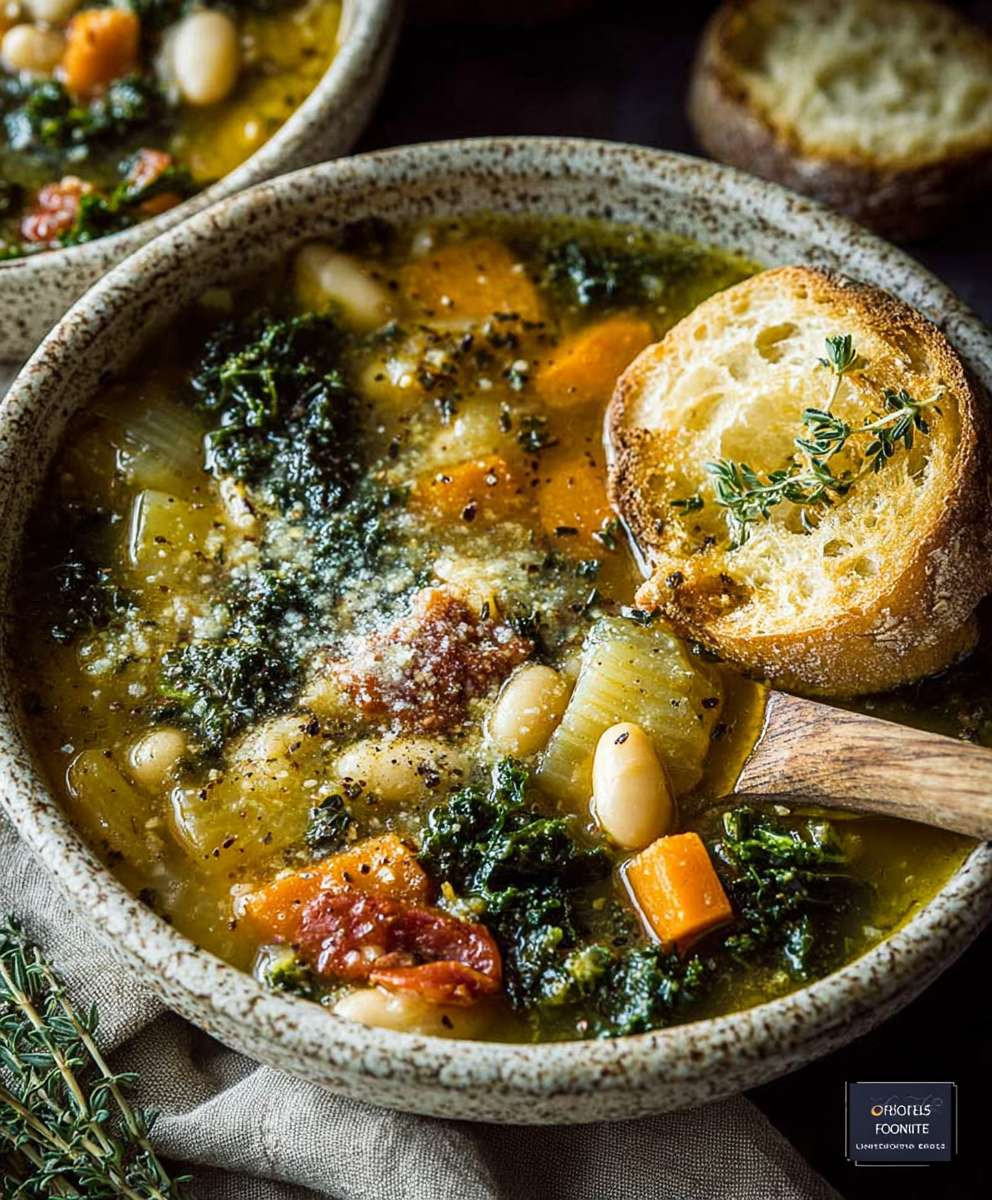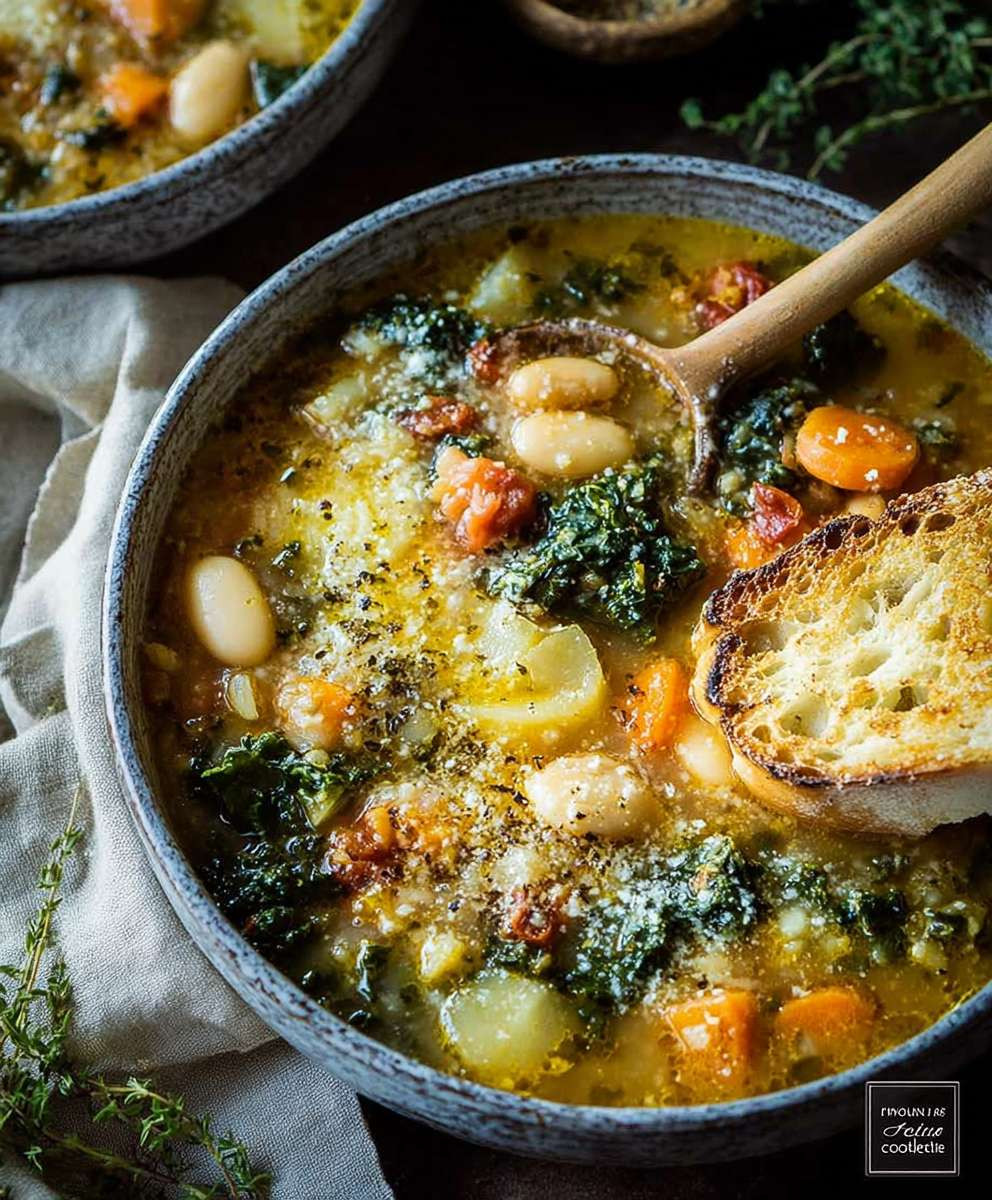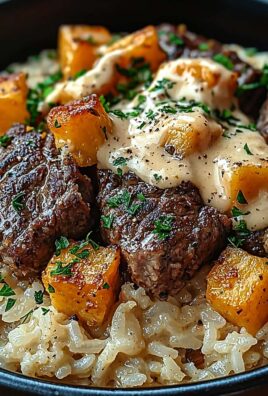Tuscan Ribollita Soup: Prepare to be transported to the heart of Tuscany with a bowl of this hearty and soul-satisfying soup! Imagine a dish so delicious, so comforting, that it was born out of resourcefulness and necessity, transforming humble leftovers into a culinary masterpiece. This isn’t just soup; it’s a taste of Italian history.
Ribollita, meaning “reboiled,” has its roots in the peasant kitchens of Tuscany. Servants would collect leftover bread and vegetables from their wealthy employers, then “reboil” them into a nourishing and flavorful meal. Over time, this resourceful dish evolved into the beloved soup we know today, a testament to the ingenuity and culinary wisdom of the Tuscan people.
What makes Tuscan Ribollita Soup so irresistible? It’s the perfect marriage of textures – the soft, yielding bread mingling with the tender vegetables, all swimming in a rich, savory broth. The earthy flavors of beans, kale, and tomatoes combine to create a symphony of taste that is both comforting and deeply satisfying. It’s a dish that warms you from the inside out, perfect for a chilly evening or any time you crave a taste of authentic Italian comfort food. Plus, it’s incredibly versatile and forgiving, allowing you to adapt it to your own preferences and available ingredients. So, let’s dive in and create a pot of this magical soup together!
Ingredients:
- Olive Oil: 3 tablespoons, extra virgin
- Pancetta: 4 ounces, diced
- Yellow Onion: 1 large, chopped
- Carrots: 2 medium, peeled and chopped
- Celery Stalks: 2, chopped
- Garlic: 4 cloves, minced
- Fresh Rosemary: 2 sprigs
- Fresh Thyme: 2 sprigs
- Lacinato Kale (or Tuscan Kale): 1 bunch, stemmed and chopped
- Cannellini Beans: 2 (15-ounce) cans, drained and rinsed
- Crushed Tomatoes: 1 (28-ounce) can
- Vegetable Broth: 8 cups
- Parmesan Rind: 1 (optional, but highly recommended!)
- Day-Old Bread: 8-10 slices, crusty Italian or sourdough, torn into bite-sized pieces
- Salt: To taste
- Black Pepper: Freshly ground, to taste
- Red Pepper Flakes: Pinch (optional)
- Fresh Parsley: Chopped, for garnish
- Extra Virgin Olive Oil: For drizzling
- Grated Parmesan Cheese: For serving
Preparing the Base: Sautéing Aromatics and Pancetta
Okay, let’s get started! The first step is building a flavorful base for our Ribollita. This is where the magic happens, so don’t rush it!
- Sauté the Pancetta: In a large, heavy-bottomed pot or Dutch oven, heat the olive oil over medium heat. Add the diced pancetta and cook, stirring occasionally, until it’s crispy and golden brown. This usually takes about 5-7 minutes. The rendered fat from the pancetta will add incredible depth of flavor to the soup.
- Add the Aromatics: Remove the pancetta from the pot with a slotted spoon and set it aside. Leave the rendered fat in the pot. Add the chopped onion, carrots, and celery to the pot. Cook, stirring occasionally, until the vegetables are softened and slightly translucent, about 8-10 minutes. Don’t let them brown too much; we want them to be sweet and flavorful, not burnt.
- Incorporate the Garlic and Herbs: Add the minced garlic, rosemary sprigs, and thyme sprigs to the pot. Cook for another minute or two, until the garlic is fragrant. Be careful not to burn the garlic, as it can become bitter. The aroma at this point should be amazing!
Building the Soup: Vegetables, Beans, and Broth
Now that we have our aromatic base, it’s time to add the heart of the Ribollita – the vegetables, beans, and broth. This is where the soup really starts to come together.
- Add the Kale: Stir in the chopped kale and cook until it wilts down slightly, about 3-5 minutes. Kale can be a bit tough, so we want to give it a head start in softening up.
- Incorporate the Beans and Tomatoes: Add the drained and rinsed cannellini beans and the crushed tomatoes to the pot. Stir well to combine everything.
- Pour in the Broth: Pour in the vegetable broth. Make sure all the vegetables are submerged in the broth.
- Add the Parmesan Rind (Optional): If you have a Parmesan rind, now is the time to add it! It will infuse the soup with a rich, cheesy flavor. Just be sure to remove it before serving.
- Season and Simmer: Season the soup with salt, black pepper, and a pinch of red pepper flakes (if using). Bring the soup to a simmer, then reduce the heat to low, cover, and simmer for at least 1 hour, or up to 2 hours. The longer it simmers, the more the flavors will meld together. Stir occasionally to prevent sticking.
Adding the Bread: The Key to Ribollita
This is what makes Ribollita, Ribollita! The bread thickens the soup and gives it its characteristic hearty texture. Don’t skip this step!
- Incorporate the Bread: After the soup has simmered for at least an hour, stir in the torn bread. Add it gradually, stirring after each addition, until the soup reaches your desired consistency. You want it to be thick and stew-like, but not too dry. You might not need all the bread, so add it little by little.
- Continue Simmering: Continue to simmer the soup, uncovered, for another 30 minutes, or until the bread has completely broken down and thickened the soup. Stir frequently to prevent sticking and to help the bread dissolve.
Finishing Touches and Serving:
Almost there! Now it’s time to put the final touches on our Ribollita and get ready to enjoy this Tuscan classic.
- Remove the Parmesan Rind: If you added a Parmesan rind, remove it from the soup before serving.
- Adjust Seasoning: Taste the soup and adjust the seasoning as needed. You might need to add more salt, pepper, or red pepper flakes to your liking.
- Stir in the Pancetta: Stir the reserved crispy pancetta back into the soup.
- Serve: Ladle the Ribollita into bowls. Drizzle with extra virgin olive oil, sprinkle with chopped fresh parsley, and top with grated Parmesan cheese.
Serving Suggestions:
Ribollita is a hearty and satisfying meal on its own, but here are a few serving suggestions to make it even more special:
- Crusty Bread: Serve with extra crusty bread for dipping into the soup.
- Grilled Cheese Croutons: For an extra cheesy and flavorful touch, top the soup with grilled cheese croutons. Simply make a grilled cheese sandwich, cut it into small squares, and float them on top of the soup.
- Arugula Salad: A simple arugula salad with a lemon vinaigrette provides a refreshing contrast to the richness of the soup.
- Red Wine: A glass of Chianti or other Tuscan red wine pairs perfectly with Ribollita.
Tips and Variations:
Ribollita is a very forgiving recipe, so feel free to experiment and make it your own! Here are a few tips and variations to get you started:
- Use Different Vegetables: Feel free to add other vegetables to the soup, such as zucchini, potatoes, or Swiss chard.
- Add Different Beans: You can use other types of beans, such as borlotti beans or Great Northern beans, instead of cannellini beans.
- Make it Vegetarian/Vegan: To make the soup vegetarian, simply omit the pancetta. To make it vegan, omit the pancetta and Parmesan rind. You can also use vegetable broth instead of chicken broth.
- Use Different Herbs: Feel free to experiment with different herbs, such as sage or oregano.
- Day-Old Bread is Key: Using day-old bread is important because it will absorb the broth better and thicken the soup properly. If you don’t have day-old bread, you can toast fresh bread in the oven until it’s slightly dried out.
- Make it Ahead: Ribollita is even better the next day, as the flavors have more time to meld together. You can make it a day or two ahead of time and store it in the refrigerator. Reheat it gently before serving.
- Freeze it: Ribollita freezes well, so you can make a big batch and freeze it in individual portions for easy weeknight meals.
Enjoy!
I hope you enjoy this recipe for Tuscan Ribollita Soup! It’s a hearty, flavorful, and comforting dish that’s perfect for a cold winter day. Buon appetito!
Conclusion:
So there you have it! This Tuscan Ribollita Soup isn’t just a recipe; it’s an experience. It’s a warm hug on a chilly evening, a celebration of simple ingredients, and a testament to the magic that happens when you slow down and let flavors meld together. I truly believe this is a must-try recipe for anyone who loves hearty, flavorful, and satisfying meals. It’s more than just soup; it’s a taste of Tuscany right in your own kitchen.
Why You Absolutely Need to Make This Soup
Honestly, where do I even begin? The depth of flavor in this ribollita is incredible. The combination of the vegetables, the beans, and the day-old bread creates a symphony of textures and tastes that will leave you wanting more. It’s also incredibly versatile. You can easily adapt it to your own preferences and dietary needs. Plus, it’s a fantastic way to use up leftover vegetables and stale bread, making it both delicious and economical. But beyond all that, it’s just plain comforting. There’s something about a big bowl of warm, hearty soup that soothes the soul, and this ribollita does just that.
Serving Suggestions and Variations
While this soup is amazing on its own, there are plenty of ways to elevate it even further. A drizzle of high-quality extra virgin olive oil just before serving adds a lovely richness and peppery note. A sprinkle of freshly grated Parmesan cheese is always a welcome addition, adding a salty and savory element. For a bit of heat, try adding a pinch of red pepper flakes. And if you’re feeling fancy, a dollop of pesto on top is absolutely divine.
As for variations, the possibilities are endless! Feel free to swap out the vegetables based on what you have on hand. Kale, spinach, or chard would all work beautifully in place of the cavolo nero. You can also experiment with different types of beans. Cannellini beans are traditional, but borlotti or even kidney beans would be delicious. If you’re not a fan of bread, you can leave it out altogether, although I highly recommend giving it a try – it’s what makes this soup so unique! For a richer flavor, you could even add a ham hock or some pancetta to the soup while it simmers. And if you’re vegetarian or vegan, simply omit the Parmesan cheese and ensure your vegetable broth is plant-based.
One of my favorite ways to serve this Tuscan Ribollita Soup is with a crusty loaf of bread for dipping. The bread soaks up all the delicious broth and adds another layer of texture to the meal. A simple side salad with a light vinaigrette is also a great accompaniment. And don’t forget a glass of your favorite Tuscan wine to complete the experience!
Now It’s Your Turn!
I’m so excited for you to try this recipe! I truly believe you’re going to love it as much as I do. Don’t be intimidated by the ingredient list – it’s all about building layers of flavor. And remember, this soup is meant to be rustic and hearty, so don’t worry about being too precise with your measurements. The most important thing is to have fun and enjoy the process. Once you’ve made it, I would absolutely love to hear about your experience. Did you make any modifications? What did you serve it with? What did your family think? Please share your thoughts and photos in the comments below. I can’t wait to see your creations! Happy cooking!
Tuscan Ribollita Soup: A Hearty & Authentic Recipe
Hearty Tuscan Ribollita soup, a bread and vegetable stew, perfect for a cold day. Features pancetta, cannellini beans, kale, and day-old bread for an authentic taste.
Ingredients
- 3 tablespoons extra virgin olive oil
- 4 ounces pancetta, diced
- 1 large yellow onion, chopped
- 2 medium carrots, peeled and chopped
- 2 celery stalks, chopped
- 4 cloves garlic, minced
- 2 sprigs fresh rosemary
- 2 sprigs fresh thyme
- 1 bunch Lacinato kale (or Tuscan kale), stemmed and chopped
- 2 (15-ounce) cans cannellini beans, drained and rinsed
- 1 (28-ounce) can crushed tomatoes
- 8 cups vegetable broth
- 1 Parmesan rind (optional)
- 8-10 slices day-old crusty Italian or sourdough bread, torn into bite-sized pieces
- Salt to taste
- Freshly ground black pepper to taste
- Pinch of red pepper flakes (optional)
- Chopped fresh parsley, for garnish
- Extra virgin olive oil, for drizzling
- Grated Parmesan cheese, for serving
Instructions
- In a large, heavy-bottomed pot or Dutch oven, heat the olive oil over medium heat. Add the diced pancetta and cook, stirring occasionally, until crispy and golden brown (5-7 minutes). Remove pancetta with a slotted spoon and set aside, leaving the rendered fat in the pot.
- Add the chopped onion, carrots, and celery to the pot. Cook, stirring occasionally, until softened and slightly translucent (8-10 minutes).
- Add the minced garlic, rosemary sprigs, and thyme sprigs to the pot. Cook for 1-2 minutes, until fragrant.
- Stir in the chopped kale and cook until it wilts slightly (3-5 minutes).
- Add the drained and rinsed cannellini beans and the crushed tomatoes to the pot. Stir well to combine.
- Pour in the vegetable broth, ensuring all vegetables are submerged.
- Add the Parmesan rind, if using.
- Season with salt, black pepper, and red pepper flakes (if using). Bring to a simmer, then reduce heat to low, cover, and simmer for at least 1 hour, or up to 2 hours, stirring occasionally.
- After simmering, stir in the torn bread gradually, until the soup reaches your desired consistency (thick and stew-like). You might not need all the bread.
- Continue to simmer, uncovered, for another 30 minutes, or until the bread has completely broken down and thickened the soup, stirring frequently.
- Remove the Parmesan rind before serving.
- Taste and adjust seasoning as needed.
- Stir the reserved crispy pancetta back into the soup.
- Ladle into bowls, drizzle with extra virgin olive oil, sprinkle with chopped fresh parsley, and top with grated Parmesan cheese.
Notes
- Serving Suggestions: Serve with crusty bread, grilled cheese croutons, an arugula salad, or a glass of Chianti.
- Vegetable Variations: Feel free to add other vegetables like zucchini, potatoes, or Swiss chard.
- Bean Variations: Use borlotti or Great Northern beans instead of cannellini.
- Vegetarian/Vegan: Omit pancetta for vegetarian; omit pancetta and Parmesan rind for vegan. Use vegetable broth.
- Herb Variations: Experiment with sage or oregano.
- Day-Old Bread: Using day-old bread is important for proper thickening. Toast fresh bread if needed.
- Make Ahead: Ribollita is even better the next day. Store in the refrigerator and reheat gently.
- Freezing: Ribollita freezes well in individual portions.





